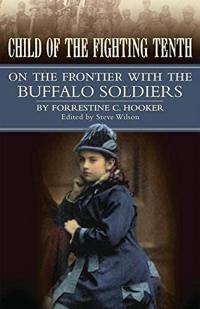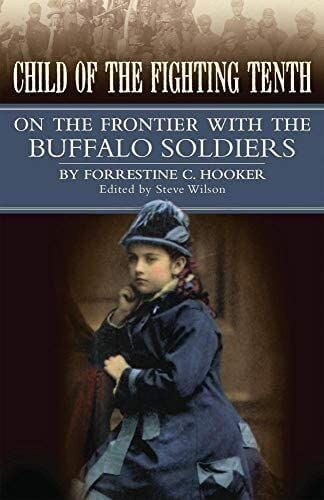Throughout her youth, Forrestine Cooper moved with her family from one army post to another. When she was born in Philadelphia on March 8, 1867, her father, Charles Laurence Cooper, was a first lieutenant with the 39th Infantry. Her first foray into the field occurred a year after her birth when Charles was sent to Ship Island, Mississippi.
In 1866, Congress had ordered the formation of black soldier regiments for the regular army, four in the infantry and two cavalry units, the 9th and 10th Cavalries. White officers commanded the Black troops.
In 1871, Charles was assigned to Company A of the 10th U.S. Cavalry and sent to Fort Sill, Indian Territory. By now, Forrestine had a brother, Harry. Her sister, Florence, was born at Fort Sill.
Forrestine wrote of her adventures while traveling with the troops in her book, “Child of the Fighting Tenth: On the Frontier with the Buffalo Soldiers,” animatedly describing countless treks across the plains. She was aware of the toll these crossings took on both her family and the soldiers.
“Buffalo herds were a common sight to my brother, my sister and myself en route with our parents from one frontier garrison to another,” she wrote. “I recollect vividly a buffalo stampede that swept across the prairie towards us ... while the soldiers waited ready to shoot into the herd in case it headed too near our wagons.”
When she was old enough to go to school, Forrestine was sent back to live with relatives in Philadelphia. She reunited with her family at Arizona’s Fort Grant in 1885 after graduating as valedictorian from St. Joseph Business College.
“The (Fort Grant) garrison was located at the base of the Graham Mountains,” she said, “the highest peak of which was Mount Graham towering 10,600 feet above sea level, while the garrison itself was at an elevation of about 7,000 feet. Across a fertile valley facing the garrison was a beautiful range of mountains, the Galiuros, and between the two mountain ranges forming the valley, thousands of cattle grazed as though in an immense, unfenced green pasture.”
Charles Cooper and his men eventually were sent to Camp Bonita in the Chiricahua Mountains. With her brother and sister away at school, Forrestine and her mother relocated to Camp Bonita even though it was considered dangerous territory. Their housing consisted of one room with the walls lined in newspaper, a delightful source of entertainment for Forrestine and her father as they vied to find articles that the other had not read.
“Often,” she said, “I would climb onto a chair to read some fresh item located near the ceiling, and after I had read it aloud, would turn to see my father’s six-foot, two-inch frame flattened on the floor as he answered my challenge by saying. ‘That’s not new. I read that long ago, but here’s something you have missed.’ Then he would triumphantly read an item located at the junction of the wall and floor.”
When Forrestine’s father asked a local rancher for the loan of a milk cow, Forrestine recalled, “(T)he old man agreed promptly, provided I would drive the cow myself, unaided, to the front door of our cabin home.” Forrestine hitched up her horse, named Don, and set off to bring home the cow.
According to Forrestine, “The cow was turned out of the corral and I began to drive her toward the camp, a distance of three miles. Until sunset the cow and I fought. She ducked, dodged, darted, then raced, and Don, getting fractious, frequently raced ahead of her, instead of at her tail. When we reached the mouth of the canyon, she simply climbed the side, and I followed after her, determined to make her go down into camp.”
About this time one of the soldiers saw the cow at the top of the bluff with Forrestine racing behind. He immediately assumed Indians were chasing the girl.
“At once the order was given to saddle up, and the troop started up the steep side of the canyon, fully armed, and prepared to rescue me from the Apaches. I managed just then to make the cow start down, calling to my father not to help.
“So the soldiers and my father watched my struggles until the cow actually was in front of the house, then they took charge of her.”
In April 1886 a neighboring ranch was attacked by warring Apaches. Troops were ordered out leaving Forrestine and her mother alone except for one soldier to protect them.
The next day pony tracks were discovered around the house and the unoccupied troop tents. Charles Cooper immediately sent his wife and daughter back to Fort Grant for safety.
At Fort Grant, Forrestine met Edwin Hooker, the son of Henry Hooker who owned the Sierra Bonita Ranch in the Sulphur Springs Valley, the largest cattle ranch in Arizona Territory at the time.
On May 4, 1886, Forrestine and Edwin were married at Fort Grant.
Forrestine lived on Sierra Bonita Ranch from 1886 until 1903. She was a big part of the ranch’s success as she learned to handle a rope, brand cattle, and eat chuck wagon food with the cowboys when out on the range.
The couple had two children, Forrestine or “Tots” as she was known, born in 1887, and Harry, born in 1888.
One of the many visitors to the Sierra Bonita Ranch was playwright Augustus Thomas who wrote the play, “Arizona,” in 1900. He used Forrestine and her life on the ranch as a model for one of his leading characters.
In 1907, Forrestine and Edwin divorced. She moved to Los Angeles, where she worked as an editor for the Los Angeles Examiner and later worked for the Los Angeles City and County Humane Society for Children. During World War I, she was instrumental in promoting the city’s Soldiers’ and Sailors’ Welfare Bureau.
In her early 50s, Forrestine began a successful writing career as a children’s author. She died in Los Angeles on March 20, 1932, at the age of 65.





